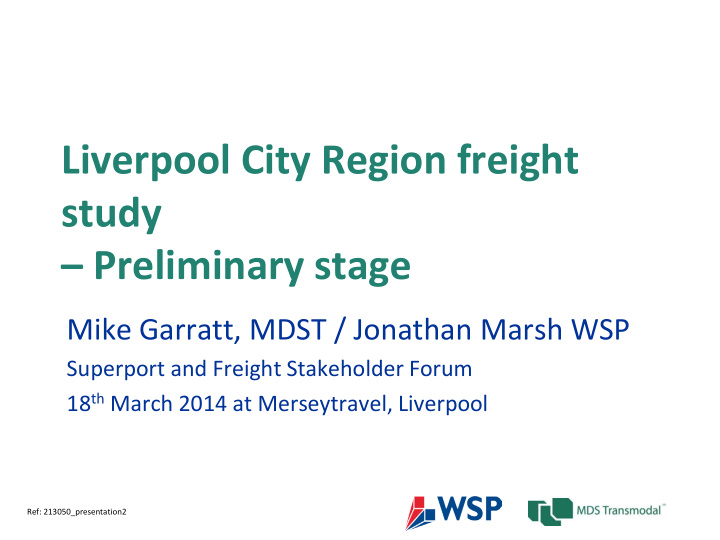



Liverpool City Region freight study – Preliminary stage Mike Garratt, MDST / Jonathan Marsh WSP Superport and Freight Stakeholder Forum 18 th March 2014 at Merseytravel, Liverpool Ref: 213050_presentation2
1. Study Objectives • Based upon the dual context of national forecasts AND the Superport vision to 2020 • To identify existing transport network pinch points & other constraints inhibiting emerging 'Superport' opportunities – to inform bidding for transport sector funding • To draw up terms of reference for a more comprehensive city region freight study – taking port, rail, urban freight and logistics issues into account
2. Approach • Run GB Freight model based upon local strategies – Liverpool 2 – rail linked distribution parks e.g. Ditton, Knowsley and others – underlying growth • Assign results onto road and rail networks • Assess changes (increased demand) against capacity
3. Road Network • Compared base year projections against 2020 • Identified change / growth through strategic assessment • Assessed impact of that change – broad conclusion that net impact of growth in freight traffic on urban network minimal – main impacts access to Seaforth (A5036), Mersey crossing (Halton) and Knowsley Industrial Park – Congestion hotspots / pinch points – key junctions • Major Schemes / HA Programme
4. Estimated HGV movements 2011/12
5. Forecast HGV movements 2020
6. Additional HGV movements
7. Freight and multimodal sites
8. 2012 to 2020 % increase in traffic/HGV's
9. Key Existing Congestion hot spots
10. Committed Highway and future prioritised schemes
11. Rail Network • Identified base year train volumes • Determined forecast train volumes – Increase in intermodal – Decline of coal – Emergency of biomass • Determined growth compared with base year projections
12. 2011 Mean freight trains per day
13. Forecast 2020 freight trains per day
14. Additional freight trains per day, 2011 - 2020
15. Additional freight paths per day 2011 - 2020
16. Rail: Key Issues • Northern Hub will increase passenger volumes along Chat Moss significantly • Current timetabling exercises highly provisional and not conflict free – and do not take into account new terminals (on/off movements) – role of Rail North to secure freight capacity within passenger franchise specification potentially crucial. • Regional access to low cost haulage to serve southern Britain depends on West Coast Main Line capacity – Liverpool City Region's DCs in competition with growth forecasts for Scotland/Greater Manchester etc. – HS2 ADDS further passenger trains north of Birmingham reducing national freight capacity – North West's overall capacity to distribute nationally negatively impacted.
17. Rail freight: West Coast Main Line • HS2 phase 1 provides marginal relief south of Rugby – but Felixstowe to Nuneaton upgrade more important in freeing up capacity for North West DCs to serve southern Britain • North of Birmingham freight demand expected to grow from 3 to 6 paths/hour by 2033 – currently little spare capacity – HS2 trains on conventional network probably deduct 2 paths – for North West to use rail to extend its distribution to reach to South East requires rail to cut costs – extension of HS2 to North West crucial if potential to be realised Yesterday's announcement therefore crucial
18. HS2 Revised plans: extension to Crewe "…. separating long-distance passenger traffic from freight and local services …. allow …. more room for freight." "…. those benefits could be spread further north sooner if Phase 2 were accelerated and the line were extended to a new regional transport hub at Crewe by 2027, 6 years earlier than planned."
19. Current demand for rail paths per day Sum of both directions
20. Forecast demand for rail paths: 2033 Sum of both directions
21. Additional demand for rail paths to 2033 Sum of both directions
22. Rail: a two way street • Intermodal rail services cater for over half of all deep-sea containers arriving in the North West – followed by feeder services – Argued rail therefore 'assists' south-east ports and has diluted role of northern ports – L2 intended to address that • Round trip container rates approximately £200/round trip lower than by road from south-east However • Introducing rail to the domestic market allows North West to penetrate southern distribution market versus Golden Triangle – given adequate rail terminal capacity – Given rail network capacity
23. North West v Midlands to the South East £ per pallet MIDLANDS North West DC Use of rail and lower £30 rent and labour costs ROAD + RAIL rROAD compensate for the longer distances involved. £15 Therefore there is a RENT + RENT + cost advantage if the LABOUR LABOUR source of the cargo is closer to the North £0 West. • Zero backloads • Sheds equidistant from source of cargo
24. The HS2 Announcement • Without simultaneous extension of HS2 to Crewe – capacity available for freight north of Birmingham less than currently used – major junction works required on WCML • With extension – HS2 passenger trains for North West/Scotland travel faster – freight capacity to Manchester better protected – remaining congestion between Crewe and Warrington • Half a solution!
25. Summary • Impact of extra freight on local road network limited to: – Seaforth to Switch Island – Halton crossing (addressed by Mersey Gateway) – Positive result for quality of local life – But potential to enhance through Urban Freight Distribution initiatives • Aspirations to expand city region hinterland through rail freight compared base year projections against 2020 and 2033 – Inhibited by Northern Hub/HS2 developments – but some encouragement yesterday – Important to identify operational or infrastructure solutions WORK IN PROGRESS!
Thank you! mike.garratt@mdst.co.uk Jonathan.Marsh@wspgroup.com
Recommend
More recommend